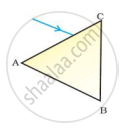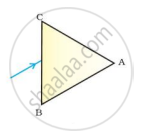Advertisements
Advertisements
प्रश्न
A ray of light incident at an angle of incidence i1 passes through an equilateral glass prism such that the refracted ray inside the prism is parallel to its base and emerges at an angle of emergence i2.
- How is the angle of emergence ‘i2’ related to the angle of incidence ‘i1’.
- What can you say about the angle of deviation in such a situation?
उत्तर
- ∠i1 = ∠i2
and refracted ray is parallel to base.
∠5 = ∠6 = 90°
∵ PQ || BC, ∠APQ = ∠AQP = 60°
∵ ΔABC is equilateral and ∠APQ and ∠AQP are corr. ∠K to ∠B and ∠C
∴ ∠2 = ∠4 ...[∵ 60° + ∠2 = 60° + ∠4]
Similarly, ∠1 = ∠3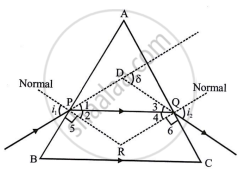
∴ ∠1 + ∠2 = ∠3 + ∠4
∴ ∠i1 = ∠i2
∵ ∠i1 = ∠1 + ∠2; ∠i2 = ∠3 + ∠4
∴ Angle of incidence = Angle of emergence is the relation when PQ || Base BC -
The angle of deviation is at its smallest when i1 = i2 and the refracted beam inside the prism is parallel to the base.
δ = i + e - A = i1 + i2- A
∵ i1 = i2 = i
δ = δmin = 2 i - A
For a given prism and given colour of light δmin is unique.
APPEARS IN
संबंधित प्रश्न
Diagrams (a) and (b) in figure below show the refraction of a ray of light of single colour through a prism and a parallel sided glass slab respectively.
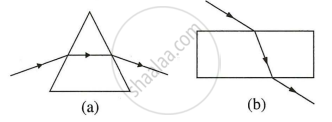
- In each diagram, label the incident, refracted, emergent rays and the angle of deviation.
- In what way the direction of emergent ray in the two cases differ with respect to the incident ray? Explain your answer.
A light ray of yellow colour is incident on an equilateral glass prism at an angel of incidence equal to 48° and suffers minimum deviation by an angle of 36°.
- What will be the angle of emergence?
- If the angle of incidence is changes to (a) 30°, (b) 60°, state whether the angle of deviation will be equal to, less than or more than 36°?
In refraction of light through a prism, the light ray ______.
A ray of light incident at an angle of incidence 48° on a prism of refracting angle 60° suffers minimum deviation. Calculate the angle of minimum deviation.
[Hint: δmin = 2i - A]
Assertion: When a pencil is partly immersed in water and held obliquely to the surface, the pencil appears to bend at the water surface.
Reason: The apparent bending of the pencil is due to the refraction of light when it passes from water to air.
A prism ABC (with BC as base) is placed in different orientations. A narrow beam of white light is incident on the prism as shown in below Figure. In which of the following diagrams, after dispersion, the third colour from the top of the spectrum corresponds to the colour of the sky?
The diagram below shows the path of a blue ray through the prism:
- Calculate the critical angle of the material of the prism for blue colour.
- What is the measure of the angle of this prism (A)?
- Which colour should replace the blue ray, for the ray to undergo Total Internal Reflection?

A monochromatic ray of light is incident on an equilateral prism placed at minimum deviation position with an angle of incidence 45° as shown in the diagram?
- Copy the diagram and complete the path of the ray PQ.
- State two factors on which the angle of deviation depends.
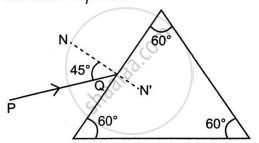
State three factors on which the angle of deviation depends.


